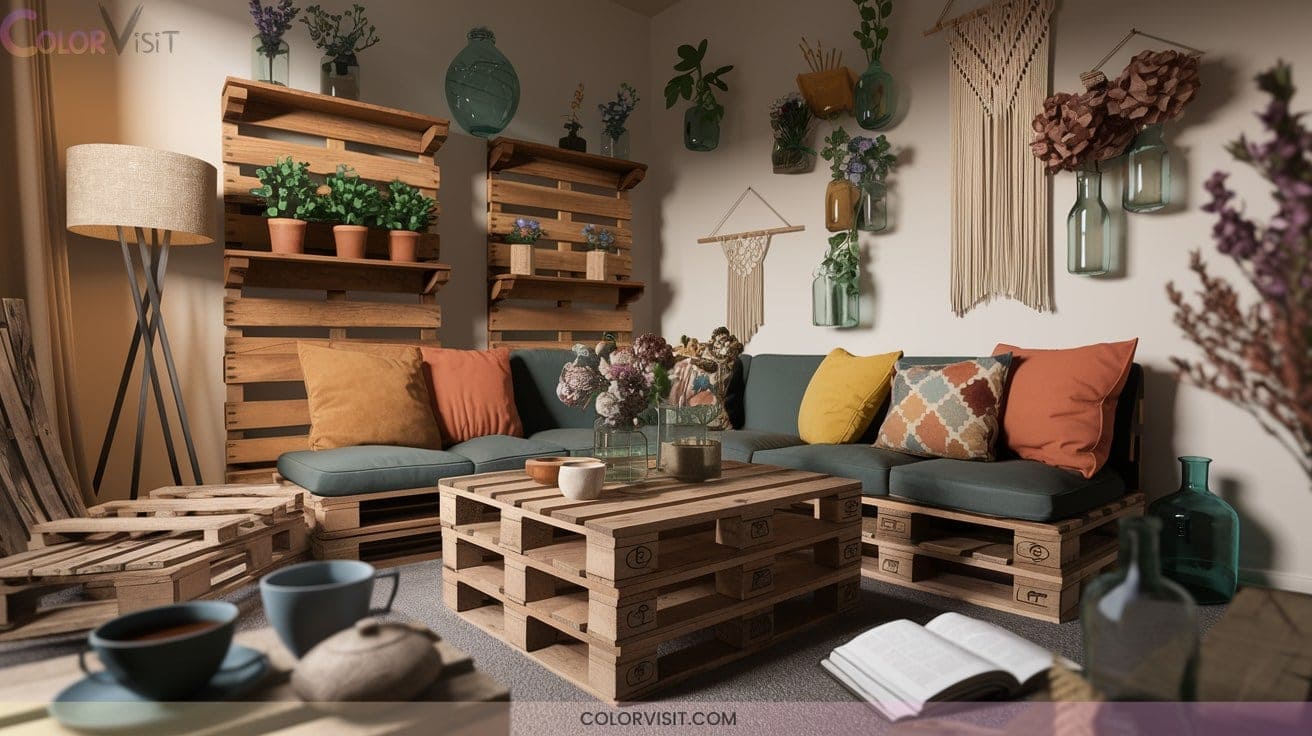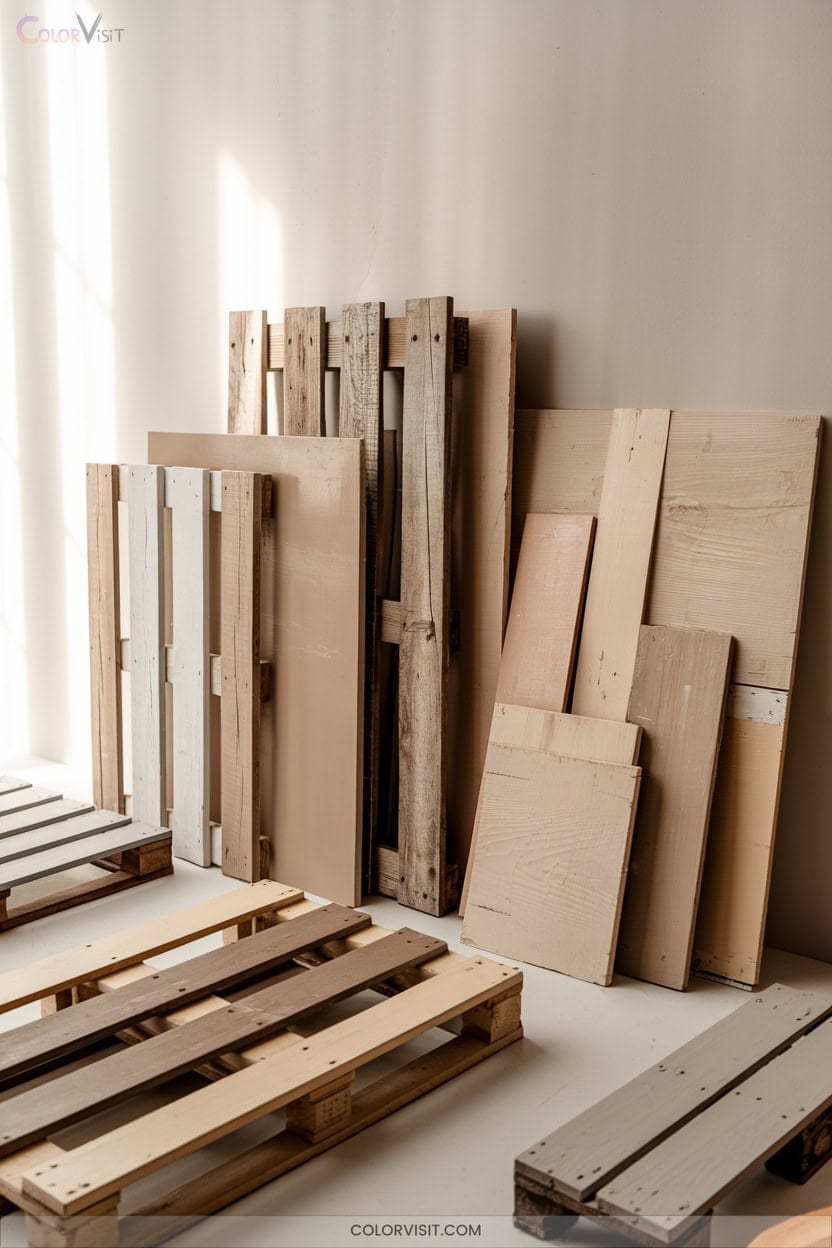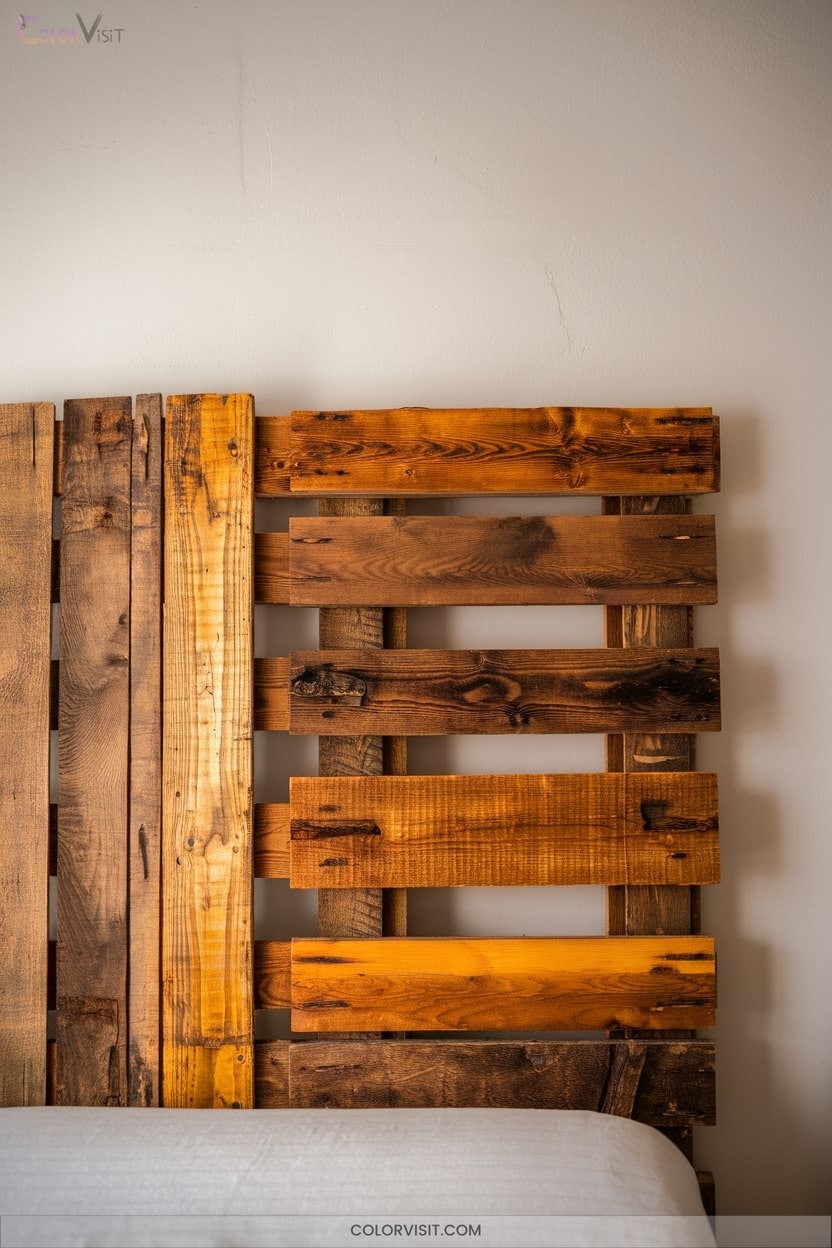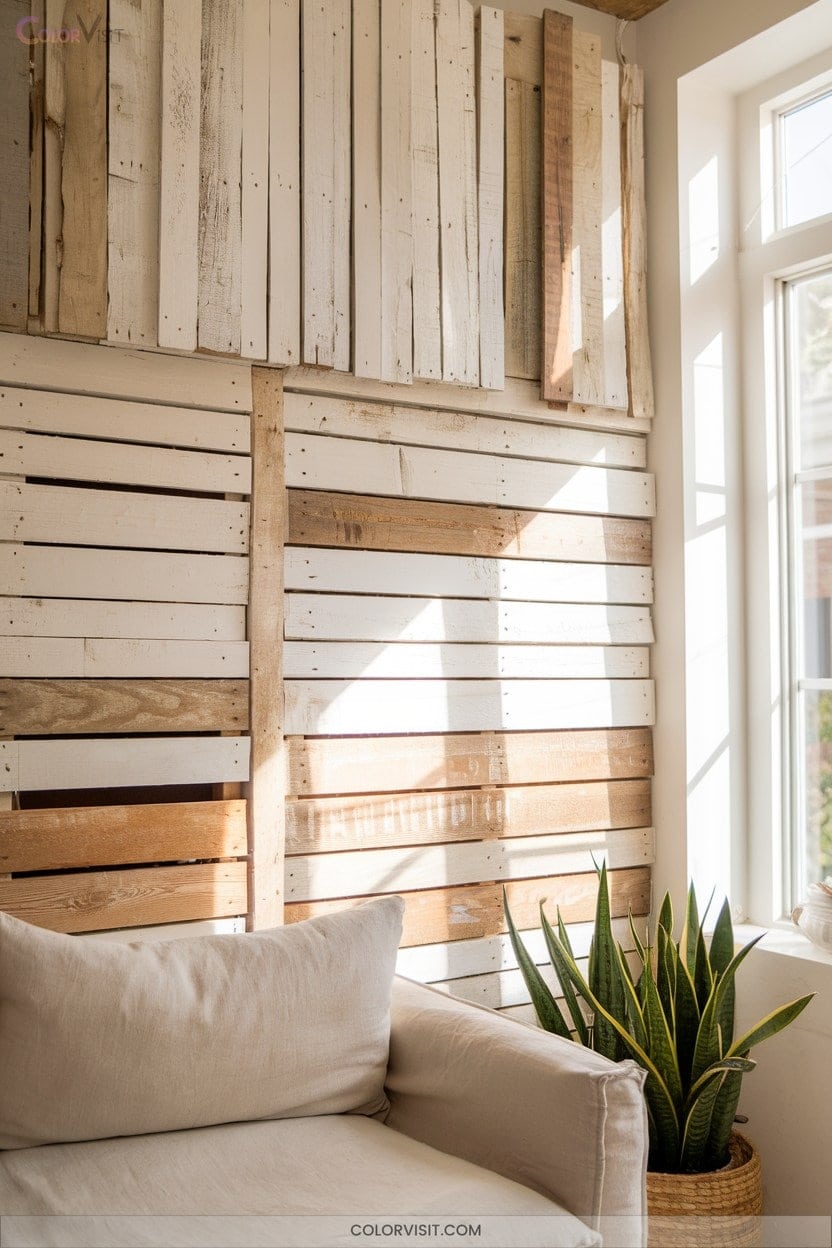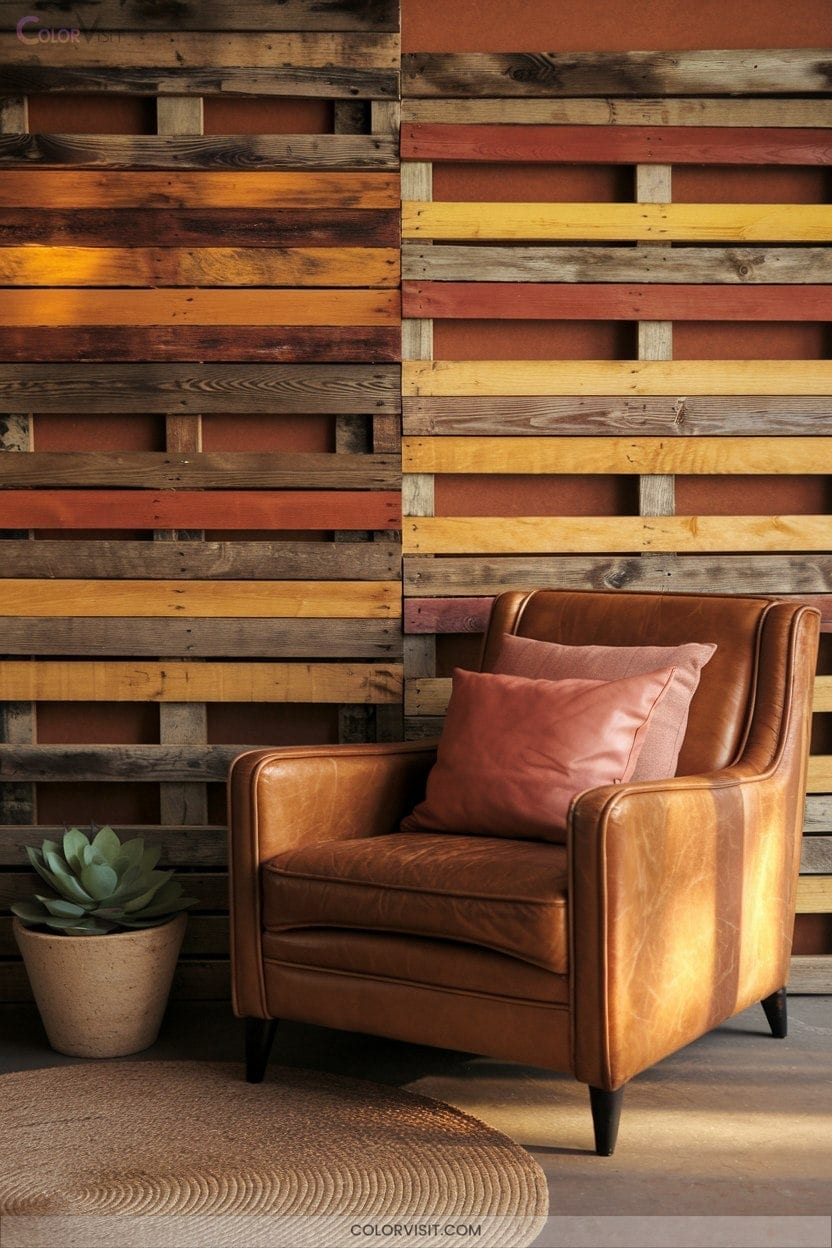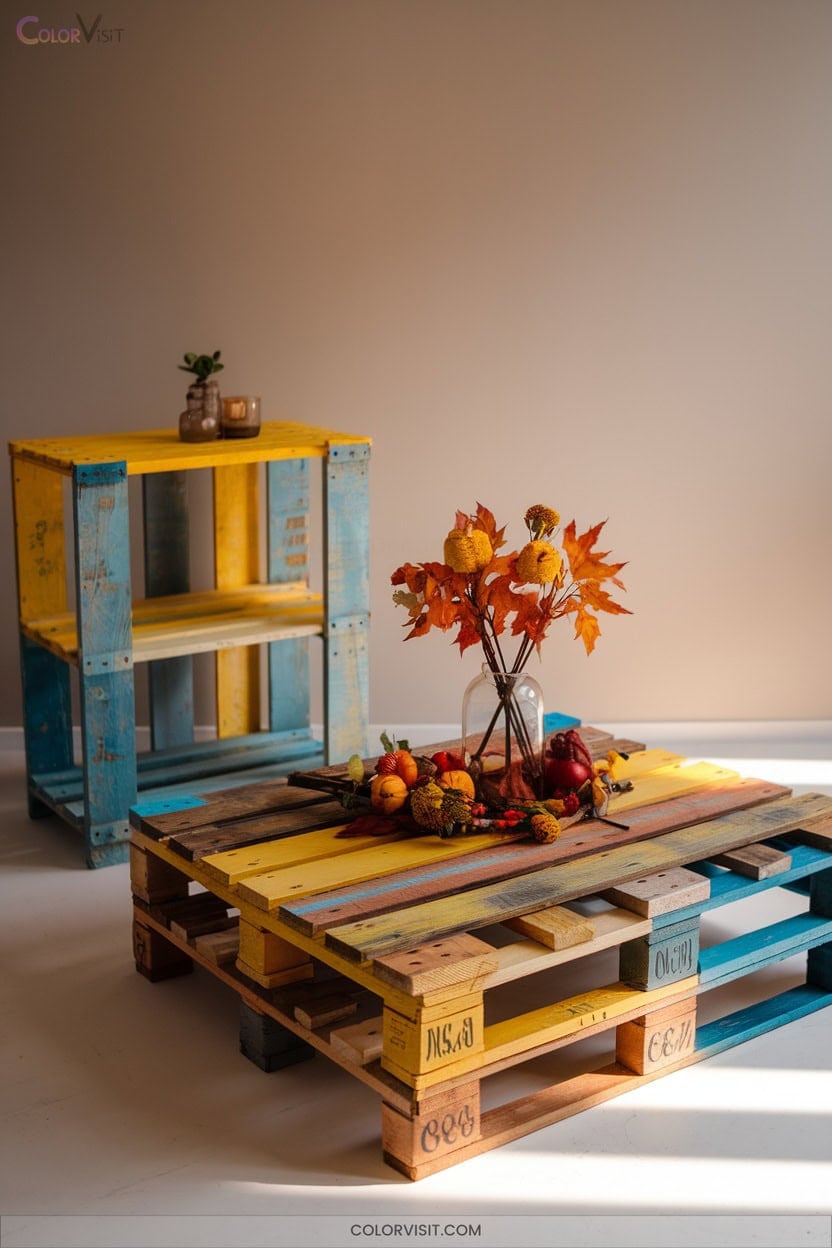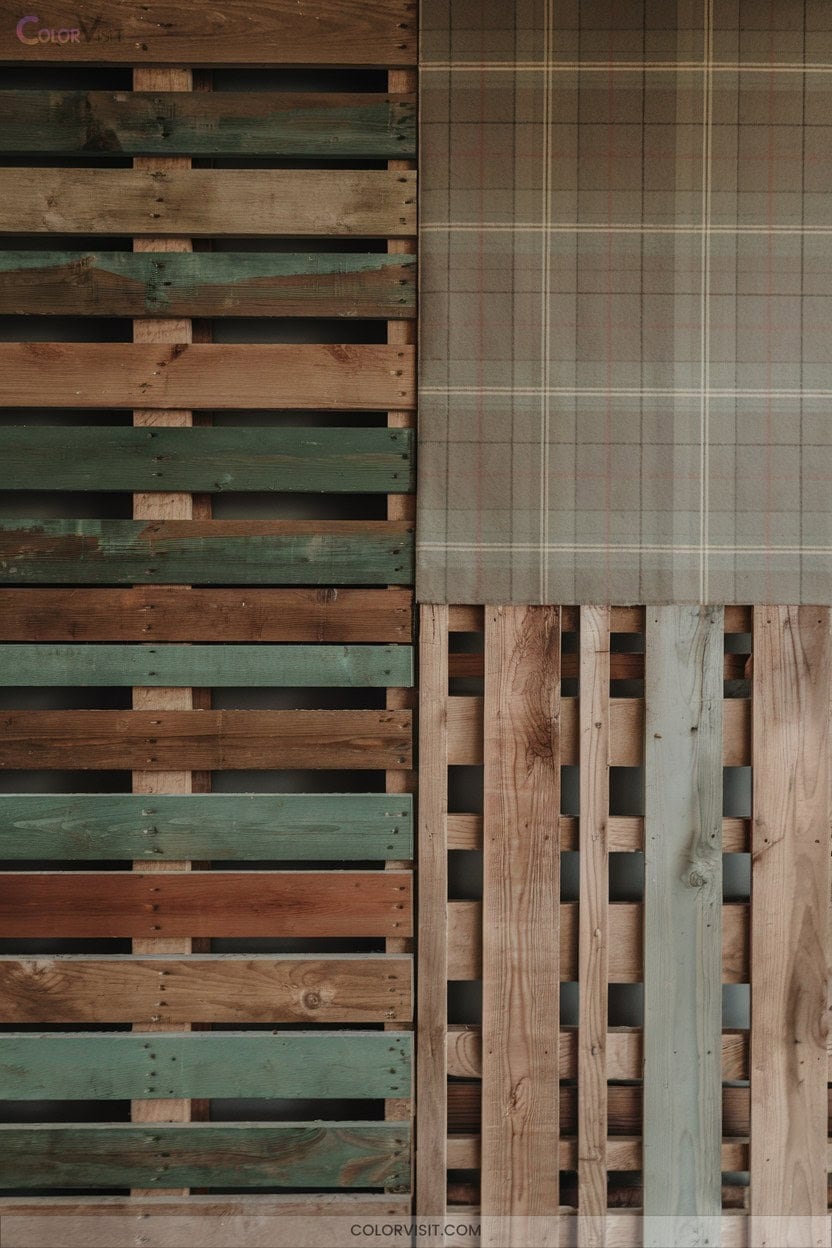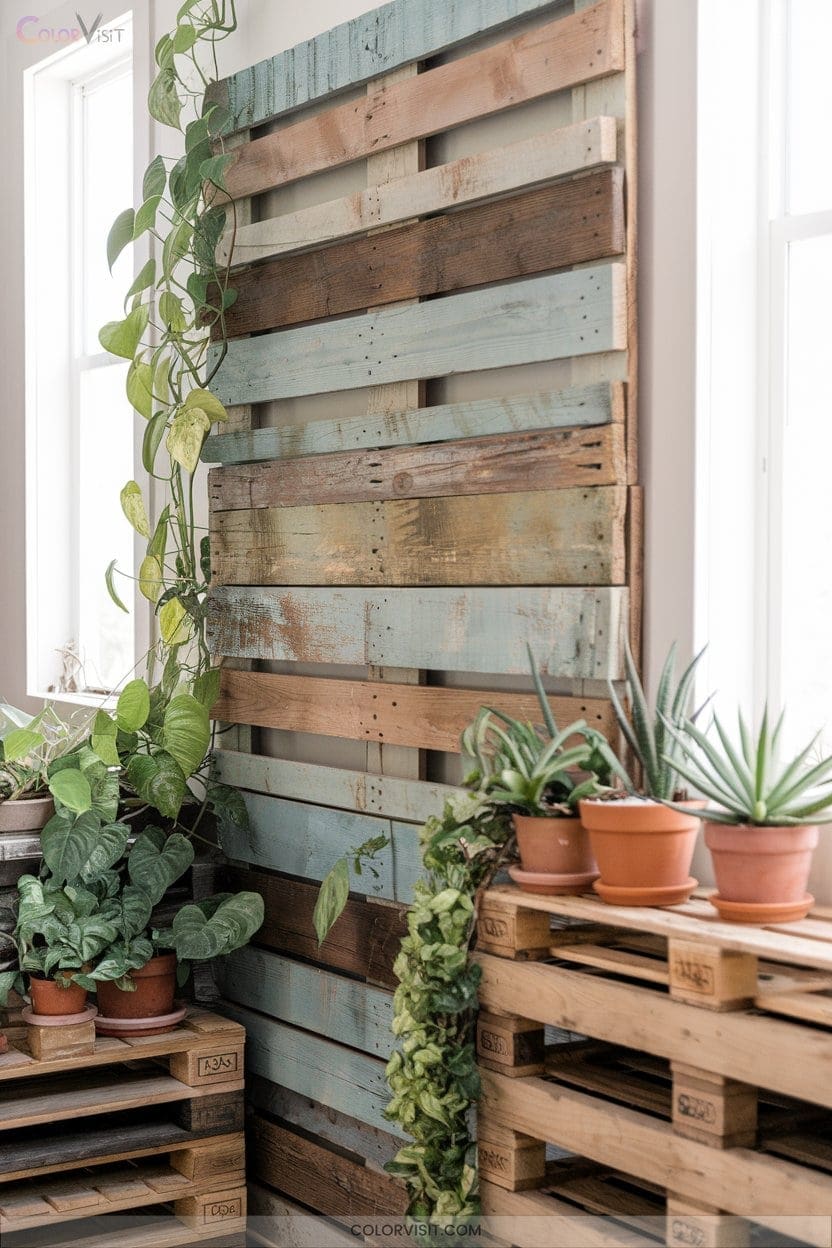14 Rustic Pallet Color Ideas for Sustainable Home Decor
Transform your space with 14 rustic pallet color ideas that blend sustainability and trend. Pair earthy greens and deep browns with creamy neutrals for grounded warmth, or layer warm beiges, taupes, and weathered grays for a serene, tactile palette. Accent with amber golds, saffron yellows, and cool indigos for depth.
Integrate nature-inspired stripes, reimagined plaids, and local greenery for biophilic richness and authentic charm. Discover which combinations create the most inviting, eco-conscious sanctuary next.
1. Earthy Greens and Rich Browns
Why do earthy greens and rich browns remain essential to rustic interiors?
You’re harnessing the biophilic trend, creating grounded, immersive spaces with hues like sage (#5F7161) and chocolate brown (#5C4033).
Harness the biophilic trend with grounded hues like sage and chocolate brown to create immersive, nature-inspired rustic spaces.
Pair forest greens with deep browns—think Sherwin-Williams Basil and Urbane Bronze—against creamy neutrals to prevent visual weight.
Layer reclaimed wood, linen textiles, and jute rugs for organic depth.
Integrate charcoal accents or vintage brass hardware for modern contrast without overpowering.
Opt for low-VOC paints and salvaged materials for sustainability.
This palette’s authenticity, tactile richness, and eco-conscious appeal define next-generation rustic design, aligning aesthetics with environmental responsibility.
2. Warm Neutral Palettes With Beige and Taupe
A refined warm neutral palette anchored by beige and taupe instantly elevates rustic interiors, balancing trend-forward appeal with timeless comfort.
Opt for warm beige—think Accessible Beige—and nuanced taupe to create a layered, inviting foundation.
Integrate natural wood accents and reclaimed furnishings for tactile depth while soft linen or wool textiles amplify coziness.
Curate metallic touches in brass or copper for subtle sophistication.
Eco-friendly elements—like natural fiber rugs, earthy pottery, and energy-efficient lighting—underscore sustainability.
Use greenery and art with earthy tones for organic vibrancy.
This palette seamlessly adapts to living rooms, bedrooms, or kitchens, offering serene, innovative rustic elegance.
3. Autumn Harvest Tones With Gold and Amber
Embrace the rich spectrum of autumn harvest tones—think gold, amber, and cinnamon brown—to infuse your rustic palette with instant warmth and visual depth.
These hues channel nature’s seasonal shift, creating spaces that feel both innovative and grounded.
Layer amber gold (#E6AA68) and saffron yellow (#D9943A) with sustainable materials for a palette that feels current and enduring.
Gold metallics introduce contemporary luxury without sacrificing authenticity.
Prioritize color harmonies that evoke comfort while reflecting eco-conscious sensibilities.
- Amber and gold metallic accents for modern rustic style
- Saffron yellow for a vibrant, energetic boost
- Cinnamon brown grounding natural textures
- Sustainable materials amplifying autumnal hues
4. Forest-Inspired Deep Greens
Step into the richness of forest-inspired deep greens, where #228B22 anchors your palette with sophisticated, natural depth.
Experience the sophisticated depth of forest-inspired green, as #228B22 grounds your space in natural elegance and tranquility.
Use this hue on reclaimed wood pallet furniture or low-VOC painted walls to create a calming, biophilic sanctuary.
Contrast with #8A2BE2 and #9370DB in textiles or artwork for a bold, trend-forward aesthetic.
Layer jute rugs and terracotta pots to amplify earthy texture, while linen upholstery in olive tones invites tactile comfort.
Integrate energy-efficient, warm LED lighting to emphasize green’s grounding effect.
This versatile base adapts seamlessly to Nordic minimalism, industrial lofts, or Mediterranean villas—delivering sustainable innovation with timeless visual impact.
5. Creamy Whites and Soft Ivory Accents
Soft ivory and creamy whites instantly elevate rustic palettes with their tranquil, light-diffusing properties.
These tones evoke serenity, sophistication, and a sense of purity—ideal for innovative, eco-forward interiors.
Pair creamy whites with tactile natural fibers or reclaimed wood to reinforce organic authenticity.
Prioritize low-VOC paints and plant-based dyes to maintain sustainable integrity.
For trend-driven impact, layer soft beige (#F8F0E3) and warm taupe (#D6B8A0) with refined metallic touches.
- Upcycle ivory-toned hemp or linen for textile accents
- Contrast creamy cabinetry with butcher-block counters
- Style with terracotta pots for earthy dimension
- Select OEKO-TEX® certified linens for toxin-free luxury
6. Woodland Blues for a Fresh Rustic Look
A woodland-inspired blue palette infuses rustic spaces with fresh tranquility, channeling the serene interplay of sky and water among forest canopies.
Integrate muted teals, powder blues, and deep indigos on reclaimed pallet wood to evoke forest streams and open skies—hallmarks of biophilic design.
Muted teals and deep indigos on reclaimed pallet wood bring the tranquil spirit of woodland streams and open skies indoors.
Pair these blues with olive greens, rich browns, and soft grays for layered, cohesive depth that feels innovative yet grounded.
Use blue-painted pallet accent walls, shelving, or furniture to visually expand and lighten rustic interiors, while blue textiles and decor details maintain a calming, contemporary vibe.
This approach pioneers sustainable style with modern woodland sophistication.
7. Sunset Reds and Burnt Orange Highlights
While woodland blues offer soothing calm, infusing your rustic space with sunset reds and burnt orange instantly amplifies warmth and energy.
These hues—ranging from deep sienna to fiery Chilean fire—imbue pallet wood with dynamic visual depth.
Use them strategically to highlight grain, create accent edges, or layer matte finishes for a lived-in, sustainable vibe.
Their psychological impact fosters comfort and social connection, making them ideal for communal zones.
Pair with muted grays or golden yellows for balance and sophistication.
Innovate with tonal gradations for a modern, cozy statement.
- Matte burnt orange accent edges
- Sunset red statement walls
- Layered sienna finishes
- Golden yellow highlights
8. Reclaimed Wood and Natural Material Combinations
Texture defines the soul of rustic design, and pairing reclaimed wood with other natural materials elevates both visual intrigue and tactile richness.
Source barn wood, shipping pallets, or even bridge timber for coffee tables, mantels, and shelving—each piece brings singular, storied character.
Fuse weathered wood with stone for depth, or integrate metal for industrial-chic edge.
Canvas and burlap add organic contrast, while a touch of greenery amplifies the raw, eco-conscious narrative.
These juxtapositions don’t just reduce your carbon footprint—they launch your aesthetic into the vanguard of sustainable, textured interiors where innovation meets authenticity in every grain and fiber.
9. Sustainable Textiles in Rustic Hues
Textiles anchor rustic spaces, grounding them in authenticity and eco-conscious innovation. Embrace sustainable materials like mulberry silk-cotton blends for airy drapery or linen-cotton mixtures for robust upholstery, both enhancing tactile depth.
Upcycled and handwoven textiles fuse tradition with environmental stewardship, while zero-waste production methods redefine efficiency. Choose earthy terracotta, muted pastels, or tranquil blues to harmonize with rustic palettes. Ikat, batik, and natural dye techniques bring global artistry into your home, creating visually compelling layers.
Sustainable textiles and artisanal techniques weave authenticity and global artistry into rustic spaces, creating layers of tactile and visual harmony.
- Upcycled fabrics for sustainable uniqueness
- Handloom weaving supporting artisanal heritage
- Nature-inspired colorways for serene ambiance
- Zero-waste textiles maximizing eco-innovation
10. Vintage Leather and Earth-Toned Fabrics
A curated mix of vintage leather and earth-toned fabrics instantly defines a rustic palette with tactile richness and visual depth.
Integrate antique saddle tans and burnished ambers—crafted by artisans using vegetable tanning or saddle stitching—alongside ochre linen, clay red cotton, and screen-printed feedsack motifs.
Layering distressed leather with upcycled grain-sack pillows or tea-dyed curtains generates nuanced textural contrast.
Accentuate with hammered copper buttons or iron rivets for industrial edge.
Employ plant-based dyes and deadstock fabrics to achieve sustainability.
This approach honors farmhouse traditions while advancing your decor with innovative, heirloom-quality elements that balance warmth, functionality, and historical resonance.
11. Rustic Grays and Weathered Stone Colors
Stone-washed grays and weathered stone hues anchor rustic palettes with understated sophistication and natural authenticity.
When you layer warm grays inspired by aged stone, you establish a versatile, neutral foundation for innovative rustic design.
These tones harmonize beautifully with earthy greens, rich browns, and brick reds, creating depth and character.
Weathered stone shades, such as Dutch Boy’s Weathered Stone, evoke a sense of history while remaining fresh and trend-forward.
- Use warm grays as a flexible, neutral backdrop
- Integrate textured stone finishes for visual richness
- Pair with earthy tones for cohesion
- Layer grays for depth and modern rusticity
12. Seasonal Rustic Accents With Yellows and Blues
Whether you’re revitalizing your space for a new season or seeking year-round rustic vibrancy, yellow and blue accents infuse pallet designs with dynamic contrast and natural charm.
Curate your palette: think bluebell and sunray for spring, skyline blue and sandstone for summer, misty blue with maize in autumn, and midnight blue paired with mellow yellow for winter.
Layer burlap, linen, or cotton textiles to amplify tactile appeal, and integrate repurposed pallets for sustainable sophistication.
Complement these hues with seasonal motifs—florals, harvest, or snowy whites—for on-trend, visually compelling decor that evolves seamlessly with the calendar, yet feels timelessly innovative.
13. Nature-Inspired Stripes and Plaid Patterns
Infusing your rustic space with nature-inspired stripes and plaid patterns instantly elevates visual depth and authenticity.
Harness the power of earthy tones—think browns, leafy greens, and skyward blues—layered in organic stripes or reimagined plaid.
Layer earthy browns, leafy greens, and sky blues in natural stripes or imaginative plaid for a rustic, nature-inspired palette.
Alternate patterns on pallet surfaces, balancing wood-grain stripes with classic reds or forest greens for striking contrast.
Upcycle reclaimed pallets, using eco-friendly paints and nature-inspired palettes to reinforce sustainability and trend-driven aesthetics.
For a bold, innovative twist, superimpose stripes atop plaid or play with contrasting textures, ensuring every accent piece feels both grounded and dynamic.
- Earthy stripe and plaid pallet wall art
- Patterned pallet tables
- Upcycled stripe/plaid pallet shelves
- Alternating stripe-plaid pallet room dividers
14. Mixing Rustic Palettes With Local Greenery
Blending rustic palettes with local greenery instantly grounds your space in both authenticity and trend-forward sustainability.
You’ll elevate your interior by pairing earthy tones—think deep browns, muted grays, and organic greens—with botanicals like ferns or eucalyptus.
This creates a harmonious backdrop that emphasizes texture, visual balance, and biophilic design.
Maximize impact by utilizing natural lighting to highlight the interplay between reclaimed wood and vibrant foliage.
Opt for recycled materials and eco-conscious greenery to reinforce your commitment to sustainability.
Frequently Asked Questions
How Do I Maintain the Color Vibrancy of Rustic Palettes Over Time?
To maintain rustic palette color vibrancy, you’ll want to apply UV-resistant coatings, embrace layered staining for depth, and avoid harsh cleaners. Regularly inspect, touch-up, and leverage natural materials to guarantee your aesthetic remains visually compelling and on-trend.
Are Rustic Color Palettes Suitable for Small or Low-Light Spaces?
Imagine even the tiniest nook transformed into a design powerhouse—rustic color palettes excel in small or low-light spaces. You’ll amplify warmth and visual depth, leveraging tonal layering and strategic accenting for a trend-forward, space-maximizing effect.
Can I Use Rustic Colors in Modern or Minimalist Interiors?
Absolutely, you can infuse rustic colors into modern or minimalist interiors. Leverage warm neutrals, earthy tones, and organic textures to create visual depth, while sleek lines and curated accents guarantee your space stays innovative, balanced, and sophisticated.
What Eco-Friendly Paint Options Work Best for Rustic Color Schemes?
Imagine rich earth tones with zero toxins—yes, you can achieve them. Choose zero-VOC paints like Benjamin Moore Eco Spec, AFM Safecoat, or Old Fashioned Milk Paint for authentic, sustainable rustic hues and a future-forward, eco-chic finish.
How Do I Transition Rustic Palettes Between Indoor and Outdoor Spaces?
To adapt rustic palettes, you’ll harmonize earth tones and textures indoors and out, integrate biophilic accents, and echo organic motifs. Leverage shared textiles, adaptive lighting, and modular furnishings for seamless, innovative visual continuity across your living environments.
Conclusion
Why settle for ordinary when you can infuse your space with rustic palettes that echo the earth’s timeless beauty? By embracing sustainable hues—rich browns, tranquil greens, and weathered grays—you’re not just following a trend, you’re curating an atmosphere rooted in both eco-consciousness and visual harmony.
Let texture, tone, and nature-inspired patterns guide your décor decisions. Transform every room into a canvas, where sustainability and style meet in a seamless, inviting embrace.
